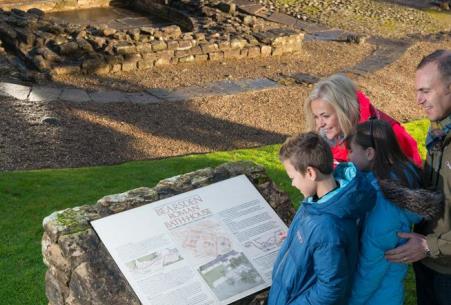The history of the Antonine Wall through digital storytelling
Published: 17 February 2017
World heritage experts will meet at the University of Glasgow to discuss how to bring the history of the Roman Antonine Wall to life through digital technology.It could entail a coast-to-coast digital map of the wall, from the Clyde to the Forth, which would provide visual images and graphics bringing the storytelling of the wall to life for visitors.
World heritage experts will meet at the University of Glasgow to discuss how to bring the history of the Roman Antonine Wall to life through digital technology.
The two day event at The Hunterian (February 22 and 23) will involve academics and experts to discuss using digital technology to help tell the story of the wall.
It could entail a coast-to-coast digital map of the wall, from the Clyde to the Forth, which would provide visual images and graphics bringing the storytelling of the wall to life for visitors.
The workshop is being held as part of a new project named Emotive, funded under the European Commission’s H2020 programme.
Emotive aims to use emotional digital storytelling to dramatically change how visitors experience heritage sites.
Funded by the European Union until 2019, the project has two goals:
- to design and develop a software platform for heritage professionals that will enable them to produce interactive, personalised, emotionally-resonant digital stories
- to allow visitors to access these stories, at museums or cultural sites, on their smartphones or tablets.
The Emotive team comprises of archaeologists and museum professionals, developers and designers, interpretive planners and writers.
“We are a diverse, multidisciplinary group, which is precisely what a project like this requires” says Dr Maria Economou, Hunterian Curator and Lecturer in Museum Studies at the University of Glasgow.
"We will be joined by 20 additional experts in interpretation, user design and gaming, and over two days the extended group will test some of the newly developed collaborative methods we have created for designing stories.
“The Antonine Wall is the perfect site for a project on storytelling. At one time there were 6,000-7,000 men stationed in forts along the Wall, many with their wives and children. Families, friends and rivals, all living in close quarters at the edge of the Roman world, imagine the personal stories.
“At The Hunterian, we have hundreds of objects from the Wall including altars, gravestones, personal artefacts and even board games. As a starting point for creating emotional stories that connect with people’s lives today, it is hard to beat.”
The Antonine Wall became a UNESCO World Heritage site in 2008. When it was constructed, nearly 2,000 years ago, it was the most northerly and complex frontier of the Roman Empire.
A second UNESCO World Heritage site will also be discussed at the workshop. Çatalhöyük, in Central Turkey. It is a Neolithic settlement which dates back 9000 years. Like The Hunterian, Çatalhöyük is a cultural partner on the Emotive project and will be used to test methods and prototypes as the Emotive software platform is developed.
“Çatalhöyük has a vast landscape of buildings and many exquisite works of art and craft,” says Dr Sara Perry, Lecturer in Cultural Heritage Management at the University of York. “Like the Antonine Wall, it’s a perfect canvas to develop and test emotionally engaging stories for visitors."
“This workshop is the first step” says Dr Economou. “We will gather key data on the process of designing emotional narratives and the mechanics of engaging with a range of artefacts, visitor types and scenarios. This will then inform the technical direction of the project as we start to develop and test the Emotive platform."
Emotive is a Research and Innovation Action project funded under the European Commission's H2020 programme that aims to use emotionally-resonant digital storytelling to dramatically change how visitors experience heritage sites. From 2016-2019, the Emotive project team will research, design, develop and evaluate a series of storytelling methods and tools for the cultural heritage sector.
Further information from the communications office: jane.chilton@glasgow.ac.uk / 0141 330 3535
First published: 17 February 2017
<< 2017

